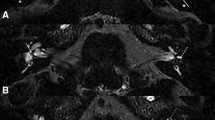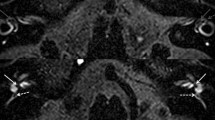Abstract
Purpose
Benign recurrent vestibulopathy is a recent entity, close to probable Meniere’s disease and vestibular-migraine. So far, no study has systematically investigated the presence of endolymphatic hydrops of the lateral semicircular canal in benign recurrent vestibulopathy using magnetic resonance imaging. The aim of this study was to determine magnetic resonance imaging data and vestibular test results in patients with benign recurrent vestibulopathy.
Methods
128 patients with benign recurrent vestibulopathy included since 2010 were retrospectively analyzed. Patients had magnetic resonance imaging with a delayed acquisition, audiogram, head shaking test, caloric-test, skull-vibration-induced-nystagmus-test, video-head- impulse-test, and vestibular evoked myogenic potential. Endolymphatic hydrops presence was classified into four categories: cochlear, saccular, lateral semicircular canal and association with saccule.
Results
In benign reccurent vestibulopathy, 23% of cases showed an endolymphatic hydrops on magnetic resonance imaging, more frequently located in the lateral semicircular canal (59%) and related to the disease duration. The most often impaired tests were caloric-test (49%) with fluctuations of hypofunction in 67% and skull-vibration-induced-nystagmus-test (61%). No correlation between the caloric-test and the presence and location of the endolymphatic hydrops was observed.
Conclusion
In our series of benign reccurent vestibulopathy, a rare endolymphatic hydrops was most often observed for the lateral semicircular canal and correlated with the seniority of the pathology. Hydrops identified at the magnetic resonance imaging was not correlated with the caloric-test results. Skull-vibration-induced-nystagmus-test and caloric-test were the most often modified vestibular tests.


Similar content being viewed by others
References
Slater R (1979) Benign recurrent vertigo. J NeurolNeurosurg Psychiatry 42:363–367. https://doi.org/10.1136/jnnp.42.4.363
Leliever WC, Barber HO (1981) Recurrent vestibulopathy. Laryngoscope 91:1–6. https://doi.org/10.1288/00005537-198101000-00001
Van Esch BF, Van Wensen E, Van der Zaag-Loonen HJ et al (2017) Clinical characteristics of benign recurrent vestibulopathy: clearly distinctive from vestibular migraine and Meniere’s disease? OtolNeurotol 38:e357–e363. https://doi.org/10.1097/MAO.0000000000001553
Lopez-Escamez JA, Carey J, Chung W-H et al (2015) Diagnostic criteria for Meniere’s disease. J Vestib Res 25:1–7. https://doi.org/10.3233/VES-150549
Lempert T, Olesen J, Furman J et al (2012) Vestibular migraine: diagnostic criteria. J Vestib Res 22:167–172. https://doi.org/10.3233/VES-2012-0453
Nakashima T, Naganawa S, Sugiura M et al (2007) Visualization of endolymphatichydrops in patients with Meniere’s disease. The Laryngoscope 117:415–420. https://doi.org/10.1097/MLG.0b013e31802c300c
Attyé A, Dumas G, Troprès I et al (2015) Recurrent peripheral vestibulopathy: is MRI useful for the diagnosis of endolymphatichydrops in clinical practice? EurRadiol 25:3043–3049. https://doi.org/10.1007/s00330-015-3712-5
Nakashima T, Naganawa S, Pyykko I et al (2009) Grading of endolymphatichydrops using magnetic resonance imaging. ActaOtolaryngolSuppl 560:5–8. https://doi.org/10.1080/00016480902729827
Attyé A, Eliezer M, Boudiaf N et al (2017) MRI of endolymphatichydrops in patients with Meniere’s disease: a case-controlled study with a simplified classification based on saccular morphology. EurRadiol 27:3138–3146. https://doi.org/10.1007/s00330-016-4701-z
Kahn L, Hautefort C, Guichard J et al (2019) Relationship between video head impulse test, ocular and cervical vestibular evoked myogenic potentials, and compartmental magnetic resonance imaging classification in Menière’s disease. Laryngoscope 130(7):E444–E452. https://doi.org/10.1002/lary.28362
Gürkov R, Flatz W, Ertl-Wagner B, Krause E (2013) Endolymphatichydrops in the horizontal semicircular canal: a morphologic correlate for canal paresis in Menière’s disease. Laryngoscope 123:503–506. https://doi.org/10.1002/lary.23395
Dumas G, Perrin P, Schmerber S (2008) Nystagmus induced by high frequency vibrations of the skull in total unilateral peripheral vestibular lesions. ActaOtolaryngol 128:255–262. https://doi.org/10.1080/00016480701477677
Dumas G, Schmerber S (2005) Comment faire un examencalorique. Ann OtolaryngolChirCervicofac 122:315–318. https://doi.org/10.1016/S0003-438X(05)82366-7
McGarvie LA, MacDougall HG, Halmagyi GM et al (2015) The video head impulse test (vHIT) of semicircular canal function—age-dependent normative values of VOR gain in healthy subjects. Front Neurol 6:154. https://doi.org/10.3389/fneur.2015.00154
Wang H-M, Tsai S-M, Chien C-Y, Ho K-Y (2012) Analysis of auditory and vestibular function in patients with unilateral Meniere’s disease. ActaOtolaryngol 132:1246–1251. https://doi.org/10.3109/00016489.2012.697641
Hofman R, Segenhout JM, Buytaert JAN et al (2008) Morphology and function of Bast’s valve: additional insight in its functioning using 3D-reconstruction. Eur Arch Otorhinolaryngol 265:153–157. https://doi.org/10.1007/s00405-007-0424-8
Quatre R, Attyé A, Karkas A et al (2019) Relationship between audio-vestibular functional tests and inner ear MRI in Meniere’s disease. Ear Hear 40:168–176. https://doi.org/10.1097/AUD.0000000000000584
Dieterich M, Brandt T (1999) Episodic vertigo related to migraine (90 cases): vestibular migraine? J Neurol 246:883–892. https://doi.org/10.1007/s004150050478
Park HJ, Migliaccio AA, Della Santina CC et al (2005) Search-coil head-thrust and caloric tests in Menière’s disease. ActaOtolaryngol 125:852–857. https://doi.org/10.1080/00016480510033667
Acknowledgments
The authors thank Mr Laurent Dumas from the pole of Pharmacology and Therapeutics (FATH), Experimental and Clinical Research Institute (IREC), University Catholique of Louvain, Brussels, Belgium, for his contribution.
Funding
All authors certify that they have no affiliations with or involvement in any organization or entity with any financial interest or non-financial interest in the subject matter or materials discussed in this manuscript.
Author information
Authors and Affiliations
Corresponding author
Additional information
Publisher's Note
Springer Nature remains neutral with regard to jurisdictional claims in published maps and institutional affiliations.
Rights and permissions
About this article
Cite this article
Ducroz, C., Dumas, G., Quatre, R. et al. Benign recurrent vestibulopathy: MRI and vestibular tests results in a series of 128 cases. Eur Arch Otorhinolaryngol 279, 169–173 (2022). https://doi.org/10.1007/s00405-021-06637-4
Received:
Accepted:
Published:
Issue Date:
DOI: https://doi.org/10.1007/s00405-021-06637-4




